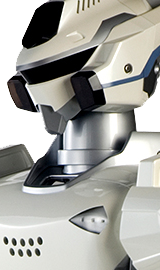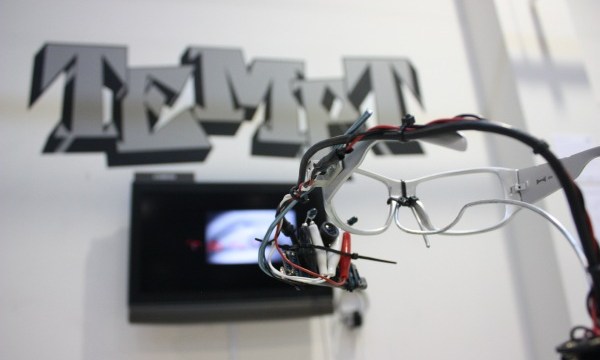Will Humanoid Robots Ever Approach the Vastness of Human Intelligence?

Right now our most advanced robots are not quite as smart as we would want them to be. One of the most popular—Honda’s humanoid robot, Asimo—is quite sophisticated but you won’t be seeing one in your home anytime soon. If you want to lease one however, simply make out a check to Honda for $150,000 — per month!
According to Honda’s Web site, they added intelligence technology which is capable of interpreting the postures and gestures of humans and moving independently in response. ASIMO’s ability to interact with humans has advanced significantly: it can greet approaching people, follow them, move in the direction they indicate, and even recognize their faces and address them by name. It can recognize faces of people, but only ones that have been pre-registered, and can recognize approximately ten different people.
Honda however is not the only game in town. You may not have heard of the others simply because Honda has better marketing—ASIMO has rung the opening bell at the New York Stock Exchange, walked the red carpet at the premier of “Robots: The Movie,” Danced with Ellen on “The Ellen DeGeneres Show” and even got spoofed on an episode of “South Park” when Eric Cartman disguised himself as Awesome-O. But other humanoid robots are currently being developed all over the world and perform similar functions and on similar technological platforms. Kawada Industries for example has developed a few prototypes of their own including the HRP-3 “Promet MK-II” which was developed for the possibility of working in an actual environment. The Kawada Web site gives detailed explanations of it’s functions including a few movies of it in operation. These kinds of robots however usually only operate with pre-programmed functions and certainly cannot think on their own.
The Mars Rovers are actually true robots and are automatons—meaning they are self-operating, can think for themselves, and make their own decisions. The problem is that the decision-making process usually takes quite long, sometimes in the hours. The Mars Exploration Rovers essentially act as robot geologists by analyzing the Martian surface (rocks, soils, etc.) and also sending back thousands of photographs to Earth. We surprised ourselves with how long these rovers have actually lasted on the surface originally thinking they would only last for 90 days. In fact, the rovers have lasted just over 6 years for operation on the Martian surface which is an amazing feat in itself. Back on Earth, NASA is tirelessly working on much more advanced version of the rover named “Curiosity” with hopes of launching it sometime next year. Click here to listen to a short audio clip about the features of the new rover which is substainally more advanced than it’s predecessors.
On another note, NASA is allowing you to send your name to Mars which will be included on a microchip along with others on the Mars Science Laboratory heading to Mars next year. Simply click here and fill out the form so your name can be included on the microchip.
In regards to the current intelligence of our most advanced robots, I think it may be decades before we develop a robot that is perhaps as smart as your dog. The problem is that the current limits of computing power doesn’t allow a robot to operate with the sophiscation as the human brain which can rewire itself or the ability to change it’s structure and function in response to an experience. For example, if someone has a stroke causing certain parts of the brain to be damaged for mobility of an arm. Neighboring areas of the brain will in most instances spring into action—rewire itself and essentially take over the function of the damaged area. We have not been able to do this with computers and it’s a feat that won’t be achieved for quite some time. Maybe in the future, true robots will walk the earth when we have quantum computers that you can put on a tabletop. Quantum computers would obviously be infinitely more powerful than current computers which would compute in a totally different way, using the laws of quantum mechanics. Presently, the most advanced quantum computer can only multiply 3×5=15 which shows that the concept in itself is still in it’s infancy.
However, one day robots will be as smart as monkeys—a point at which they could be potentially dangerous. When that happens, they should have a chip put in their brain to shut them off in the event that they get murderous thoughts. But I think that we will have plenty of time and plenty of warning before they reach the intelligence of a monkey.
So, we have learned that present day computing power doesn’t allow us to create a robot with the sophistication of higher-intelligence. We also don’t have true robots because of the common sense problem. We know that water is wet, we know that when you die you don’t come back the next day, we know that mothers are older than their daughters, we know that strings can pull but not push and we know that sticks can push but not pull, we know that we do not like pain. Robots do not “understand” these things. There is no line of mathematics that says that we don’t like pain, there is no line of computer science that says that when you die you don’t come back the next day. These things have to be learned, mostly by experience. When we touch a hot stove and burn our hand we know not to do it again because it’s hot and it hurts. A three-year-old child has more common sense than our most advanced computers because our children bump into reality—they pull strings, they get hurt and they see things die and don’t come back to life. We have tried to program the laws of common sense into robots but it takes millions of lines of common sense to even begin to approach the common sense of a 3 year old child.
So, we have our work cut out for us and advances will certainly only get better but it may be decades before we see any real progress. Movies like “AI,” “Terminator” and “Short Circuit” are exactly what they are—movies.





